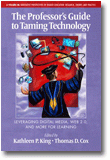
The Professor's Guide to Taming Technology
Leveraging Digital Media, Web 2.0 and More for Learning
Edited by:
Kathleen P. King, University of Central Florida
Thomas D. Cox, University of Houston-Victoria
A volume in the series: Innovative Perspectives of Higher Education: Research, Theory and Practice. Editor(s): Kathleen P. King, University of Central Florida.
Published 2011
This book is provided as a guide, encouragement and handbook for faculty to introduce digital media in language you can understand and provide strategies and activities you can quickly assimilate into your teaching. We are excited that more people will be able to benefit from the powerful help and guidance contained in this book. We are even more exhilarated as we anticipate how each of you will discover applications and new directions we would never anticipate, and look forward. We look forward to your innovations as you use the material you discover here.
This book responds to the needs of our changing world and students by revealing innovative technology applications and how faculty are and can use digital media in teaching in higher education because faculty make the quickest changes and learn how to do it best. It is a valuable resource for faculty from faculty, because it allows the sharing of successful teaching experiences with digital media with our worldwide colleagues so they may modify it, extend it, and improve it.
Moreover, in our work with faculty across all disciplines, we also find that many struggle to think about teaching in ways in which they can incorporate technology meaningfully. While we might be experts in our discipline (chemistry, philosophy, music, etc) due to the curriculum of terminal degrees, we might not have strong preparation in instructional design.
We have been fortunate to bring together faculty experts across different disciplines to specifically speak about how and why to use digital media in higher education settings. We realize we are asking you to think about your way of teaching with new ideas and strategies. Therefore, we try to illustrate them with clear examples. These different approaches include clear descriptions of what these activities look like, why to develop and implement them, and how to do so for your specific needs.
CONTENTS
Preface: Bridging the Gap of Change, Kathleen P. King. Acknowledgments. PART I: VISION AND FOUNDATIONS. Using Digital Media in Higher Education: An Adult Learning Perspective, Thomas D. Cox and Kathleen P. King. Voice, Empowerment, and Impact: Using Digital Technologies in the Classroom, Kathleen P. King. PART I I: DIGITAL MEDIA. Podcasting: Learning on Demand and Content Creation, Kathleen P. King. Using Online Asynchronous Audio Communication in Higher Education, Jody Oomen-Early, Mary Bold, Kristin L. Wiginton, and Tara Gallien. Video Development and Instructional Use: Simple and Powerful Options, Kathleen P. King and Thomas D. Cox. Blogging as Reflective Practice in the Graduate Classroom, Teresa J. Carter. Narrated Digital Presentations: An Educator's Journey and Strategies for Integrating and Enhancing Education, Brian W. Donavant. The Use of Wikis for Collaboration in Higher Education, Pooneh Lari. Virtual Office Hours, April Williams and Thomas D. Cox. Skype and Other Virtual Conferencing Tools, Ellen Manning. Facebook Goes on "Prac": Using Social Networking Tools to Support Students Undertaking Teaching Practicum, Jennifer Duncan-Howell and Rebecca English. PART I I I: SPECIAL TOPICS. Revelations of Adaptive Technology Hiding in Your Operating System, Kathleen P. King. Accessible Technology for Online and Face-to-Face Teaching and Learning, Sheryl Burgstahler and Alice AndersonMike Litzkow. Incorporating 3D Virtual Laboratory Specimens to Enhance Online Science: Examples from Paleontology and Biology, Kevin F. Downing and Jennifer K. Holtz. A Guide to Using Technology in the History Classroom, Keith Sisson and Kathleen P. King. PART IV: THINKING AHEAD. Action Steps for Continued Faculty Success in Taming Technology, Kathleen P. King and Thomas D. Cox. The Authors and Contributors.
REVIEWS
"The idea of taming technology has probably occurred to almost everyone in the field of education. This guide to the process of taming technology is written by faculty members who have managed to find ways to use various technologies to effectively support the learning process. The book is written in a style that is user-friendly and reflective of the faculty perspective. Regardless of the discipline, this guide introduces the reader to current teaching/learning technologies, explains the benefits, and provides relevant examples and references." Ed Cunliff University of Central Oklahoma in Adult Learning
"What many will find advantageous are three distinctions of the work. First, it provides the reader with ideas that arise from the classroom experience, as well as multiple perspectives from different teaching contexts. Second, each chapter contains important questions a faculty member should ask herself when considering employing a new technology in the classroom. Third, it provides limited, but very helpful, Web 2.0 recommendations. This is where the idea of taming comes across most dramatically." Michael Joseph Brown Wabash College in Teaching Theology and Religion
-
Paperback978-1-61735-333-8
Web price: $45.04 (Reg. 52.99)
-
Hardcover978-1-61735-334-5
Web price: $80.74 (Reg. 94.99)
- eBook9781617353352

- EDU015000 - EDUCATION: Higher
- EDU037000 - EDUCATION: Research
- EDU039000 - EDUCATION: Computers & Technology
-
 Case Studies for the New Professor
Surviving the Jungle of the Academy
Case Studies for the New Professor
Surviving the Jungle of the Academy
-
 Institutional Diversity in American Postsecondary Education
Institutional Diversity in American Postsecondary Education
-
 Instructional Innovations in Teaching and Learning
Instructional Innovations in Teaching and Learning
-
 Machine Learning, Natural Language Processing, and Psychometrics
Machine Learning, Natural Language Processing, and Psychometrics
-
 Pathways to Transformation
Learning in Relationship
Pathways to Transformation
Learning in Relationship
-
 Promoting Equitable Classroom Practices in Higher Education
Approaches Beyond Curriculum
Promoting Equitable Classroom Practices in Higher Education
Approaches Beyond Curriculum
-
 Reflection and the College Teacher
A Solution for Higher Education
Reflection and the College Teacher
A Solution for Higher Education

